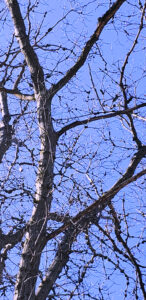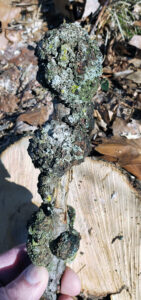
Phomopsis galls are plentiful on branches of a 120-year-old red oak tree in Clark County, Wisconsin, in 2024. / Photo Credit: Kris Wimme, retired Wisconsin DNR forester
By Alex Hornung, DNR Forest Health Specialist, Plover
Alexandra.Hornung@wisconsin.gov
It is the perfect time of year to be on the lookout for galls – woody growths or swellings on tree branches that are typically oblong in shape and of varying sizes.
They can often be found on small branches, but occasionally they can affect large branches or even the main stem. Galls can occur for several reasons, ranging from fungi to bacteria to insect activity.
One type, Phomopsis gall, can be particularly impressive to see. Galls formed due to this native fungus mostly occur on oak, hickory and maple trees in Wisconsin.

A close-up of a branch from a red oak tree in Clark County showing a phomopsis gall. / Photo Credit: Kris Wimme, retired Wisconsin DNR forester
Notably, though galls can sometimes be found in spectacular numbers on a particular tree, their presence generally doesn’t lead directly to rapid or widespread tree mortality. Often, trees that have low-to-moderate numbers of galls will have a normal-looking canopy – which is why spotting this phenomenon is easier after leaves fall off for the winter.
Another interesting aspect of Phomopsis is that trees that are heavily galled can be found standing next to trees of the same species that have few to zero galls. This would suggest some range of susceptibility between trees that is not yet well understood.
Galls are slow-growing and do not cause extensive damage unless they make up more than 50 percent of the circumference of the stem. Damage from galls is usually observed as branch dieback and a reduction in vigor, which could be exacerbated if the tree experiences other stressors such as drought or defoliation from other insects or diseases.
Management of galls can include pruning out the affected area, if feasible. But that is usually not necessary if the branches affected are otherwise healthy and asymptomatic.
Many choose not to prune out the galls and would prefer to enjoy them as a fantastic anomaly. I know I would!
